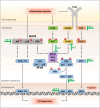Melatonin, an Antitumor Necrosis Factor Therapy
- PMID: 39740227
- PMCID: PMC11685806
- DOI: 10.1111/jpi.70025
Melatonin, an Antitumor Necrosis Factor Therapy
Abstract
Tumor necrosis factor (TNF) is a biomarker of inflammation whose levels are elevated in patients with several diseases associated with dysregulation of the immune response. The main limitations of currently used anti-TNF therapies are the induction of immunodepression, which in many cases leads to serious adverse effects such as infection and cancer, and the inability to cross the blood-brain barrier in neuroinflammatory conditions. Melatonin, in addition to being a chronobiotic compound, is widely known for its antioxidant and immunomodulatory capacity to control inflammatory processes in different pathological contexts. The aim of the present review is to address human-based studies that describe the effect of melatonin on TNF production. The review includes all the articles published in PubMed databases until April 15, 2024. After depuration, 45 studies were finally included in the review, 23 related to the in vitro action of melatonin in human cells and 22 in vivo studies in humans. Most of the data reviewed support the idea that melatonin has an immunosuppressive effect on TNF levels, which, together with its low toxicity profile, low cost, and ability to cross the blood-brain barrier, points to melatonin as a potential anti-TNF therapy. Therefore, improving our knowledge of the action of melatonin in regulating TNF through appropriate clinical trials would reveal the true potential of this molecule as a possible anti-TNF therapy.
Keywords: TNF; anti‐TNF therapy; chronic inflammation; humans; immunomodulation; inflammatory disease; melatonin.
© 2024 The Author(s). Journal of Pineal Research published by John Wiley & Sons Ltd.
Figures



Similar articles
-
Melatonin reverses tumor necrosis factor-alpha-induced metabolic disturbance of human nucleus pulposus cells via MTNR1B/Gαi2/YAP signaling.Int J Biol Sci. 2022 Mar 6;18(5):2202-2219. doi: 10.7150/ijbs.65973. eCollection 2022. Int J Biol Sci. 2022. PMID: 35342351 Free PMC article.
-
Melatonin attenuates chronic stress-induced hippocampal inflammatory response and apoptosis by inhibiting ADAM17/TNF-α axis.Food Chem Toxicol. 2022 Nov;169:113441. doi: 10.1016/j.fct.2022.113441. Epub 2022 Sep 24. Food Chem Toxicol. 2022. PMID: 36162616
-
Anti-inflammatory effects of melatonin: A systematic review and meta-analysis of clinical trials.Brain Behav Immun. 2021 Mar;93:245-253. doi: 10.1016/j.bbi.2021.01.034. Epub 2021 Feb 10. Brain Behav Immun. 2021. PMID: 33581247 Free PMC article.
-
The Protective Effects of Melatonin Against Oxidative Stress and Inflammation Induced by Acute Cadmium Exposure in Mice Testis.Biol Trace Elem Res. 2016 Mar;170(1):152-64. doi: 10.1007/s12011-015-0449-6. Epub 2015 Jul 30. Biol Trace Elem Res. 2016. PMID: 26224376
-
Melatonin as a Chronobiotic and Cytoprotector in Non-communicable Diseases: More than an Antioxidant.Subcell Biochem. 2024;107:217-244. doi: 10.1007/978-3-031-66768-8_11. Subcell Biochem. 2024. PMID: 39693027 Review.
Cited by
-
Melatonin from Plants: Going Beyond Traditional Central Nervous System Targeting-A Comprehensive Review of Its Unusual Health Benefits.Biology (Basel). 2025 Jan 30;14(2):143. doi: 10.3390/biology14020143. Biology (Basel). 2025. PMID: 40001911 Free PMC article. Review.
-
Melatonin Synergises the Chemotherapeutic Effect of Temozolomide in Glioblastoma by Suppressing NF-κB/COX-2 Signalling Pathways.J Cell Mol Med. 2025 Aug;29(15):e70778. doi: 10.1111/jcmm.70778. J Cell Mol Med. 2025. PMID: 40804775 Free PMC article.
References
-
- Michishita M., Yoshida Y., Uchino H., and Nagata K., “Induction of Tumor Necrosis Factor‐Alpha and Its Receptors During Differentiation in Myeloid Leukemic Cells Along the Monocytic Pathway. A Possible Regulatory Mechanism for TNF‐Alpha Production,” Journal of Biological Chemistry 265, no. 15 (1990): 8751–8759, http://www.ncbi.nlm.nih.gov/pubmed/2160467. - PubMed
-
- Annunziato F., Cosmi L., Liotta F., et al., “Phenotype, Localization, and Mechanism of Suppression of CD4(+)CD25(+) Human Thymocytes,” Journal of Experimental Medicine 196, no. 3 (2002): 379–387, http://www.ncbi.nlm.nih.gov/pubmed/12163566. - PMC - PubMed
Publication types
MeSH terms
Substances
LinkOut - more resources
Full Text Sources
Miscellaneous

